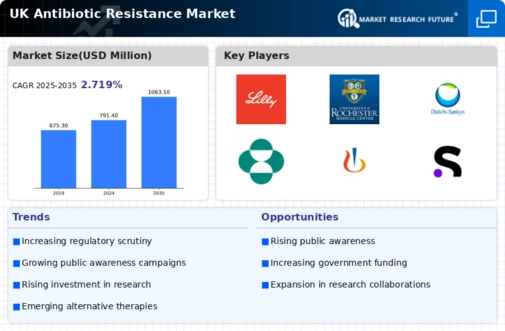Government Initiatives and Funding
The UK government has recognized the threat posed by antibiotic resistance and is actively implementing initiatives to combat antibiotic resistance. The UK Antimicrobial Resistance (AMR) Strategy aims to reduce antibiotic use in humans and animals by 15% by 2024. This strategic approach is likely to stimulate the antibiotic resistance market as funding is allocated for research and development of new antibiotics and alternative therapies. The government has committed £20 million to support innovative projects aimed at tackling AMR, which could lead to breakthroughs in treatment options. Additionally, public health campaigns funded by the government are raising awareness about responsible antibiotic use, further driving the market. As these initiatives unfold, the antibiotic resistance market is expected to expand, attracting investments and fostering innovation.
Technological Advancements in Diagnostics
Advancements in diagnostic technologies are transforming the antibiotic resistance market in the UK. Rapid and accurate diagnostic tools enable healthcare providers to identify resistant infections more effectively, leading to targeted treatment strategies. The market for diagnostic solutions is projected to grow significantly, with an estimated CAGR of 10% over the next five years. Technologies such as next-generation sequencing and point-of-care testing are becoming increasingly prevalent, allowing for quicker results and improved patient outcomes. This shift towards precision medicine is likely to enhance the overall efficiency of antibiotic use, thereby addressing the challenges posed by resistance. As healthcare systems adopt these innovations, the antibiotic resistance market is poised for substantial growth, driven by the demand for effective diagnostic solutions.
Collaboration Between Public and Private Sectors
Collaboration between public health organizations and private sector companies is emerging as a significant driver for the antibiotic resistance market. Partnerships aimed at addressing antibiotic resistance are fostering innovation and accelerating the development of new treatments. The UK government has initiated several collaborative projects, bringing together academia, industry, and healthcare providers to tackle AMR. These collaborations are likely to enhance research efforts and streamline the regulatory process for new antibiotics. Additionally, funding from both public and private sources is expected to increase, supporting the antibiotic resistance market's growth. As these partnerships evolve, they may lead to the introduction of novel therapies and solutions, ultimately benefiting patients and healthcare systems across the UK.
Increased Awareness of Antimicrobial Stewardship
The growing emphasis on antimicrobial stewardship programs in the UK is a pivotal driver for the antibiotic resistance market. These programs aim to optimize the use of antibiotics, ensuring they are prescribed only when necessary. As healthcare providers and institutions adopt these practices, the demand for educational resources and training is likely to increase. The antibiotic resistance market may benefit from this trend as pharmaceutical companies develop tools and resources to support stewardship initiatives. Furthermore, the UK government has set ambitious targets to reduce antibiotic prescriptions by 10% by 2025, which could further stimulate market growth. The focus on responsible antibiotic use is expected to lead to a more sustainable market environment, fostering innovation and the development of new therapies.
Rising Incidence of Antibiotic-Resistant Infections
The increasing prevalence of antibiotic-resistant infections in the UK is a critical driver for the antibiotic resistance market. Reports indicate that approximately 5,000 deaths annually in the UK are attributed to antibiotic resistance, highlighting the urgent need for effective solutions. This alarming trend compels healthcare providers and policymakers to invest in innovative treatments and preventive measures. The antibiotic resistance market is likely to experience growth as hospitals and clinics seek advanced antibiotics and alternative therapies to combat resistant strains. Furthermore, the economic burden of these infections, estimated at £1 billion annually in the UK, underscores the necessity for robust market responses. As awareness of this issue grows, the demand for new antibiotics and diagnostic tools is expected to rise, propelling the antibiotic resistance market forward.
























Leave a Comment